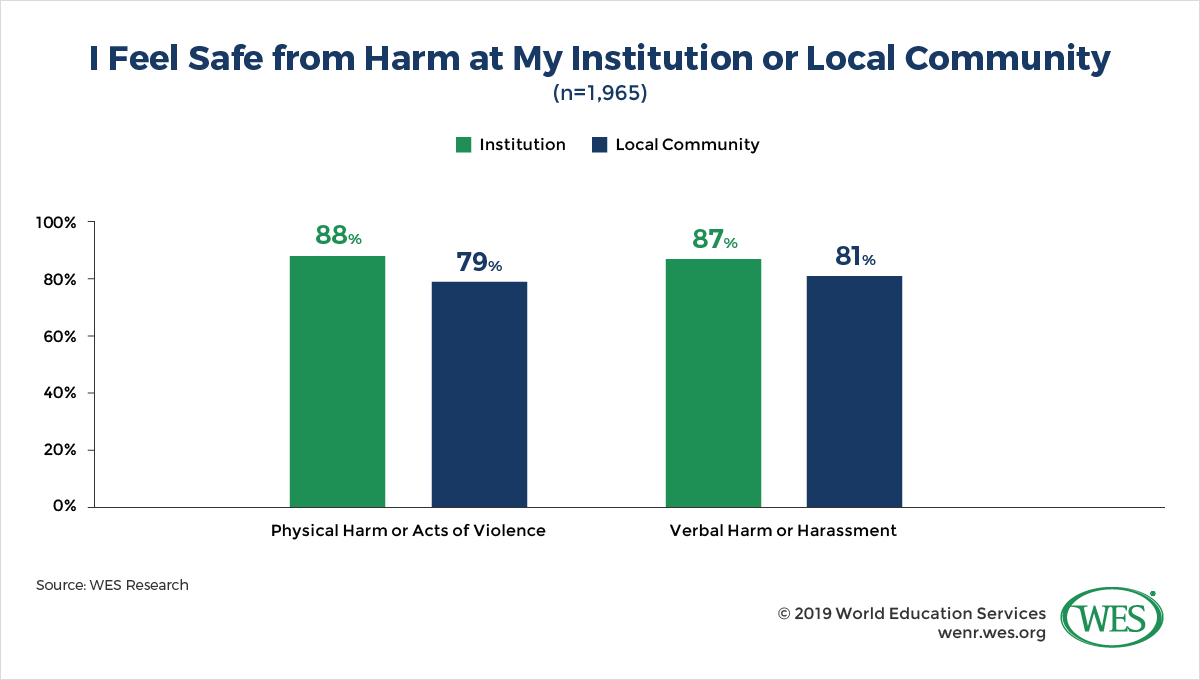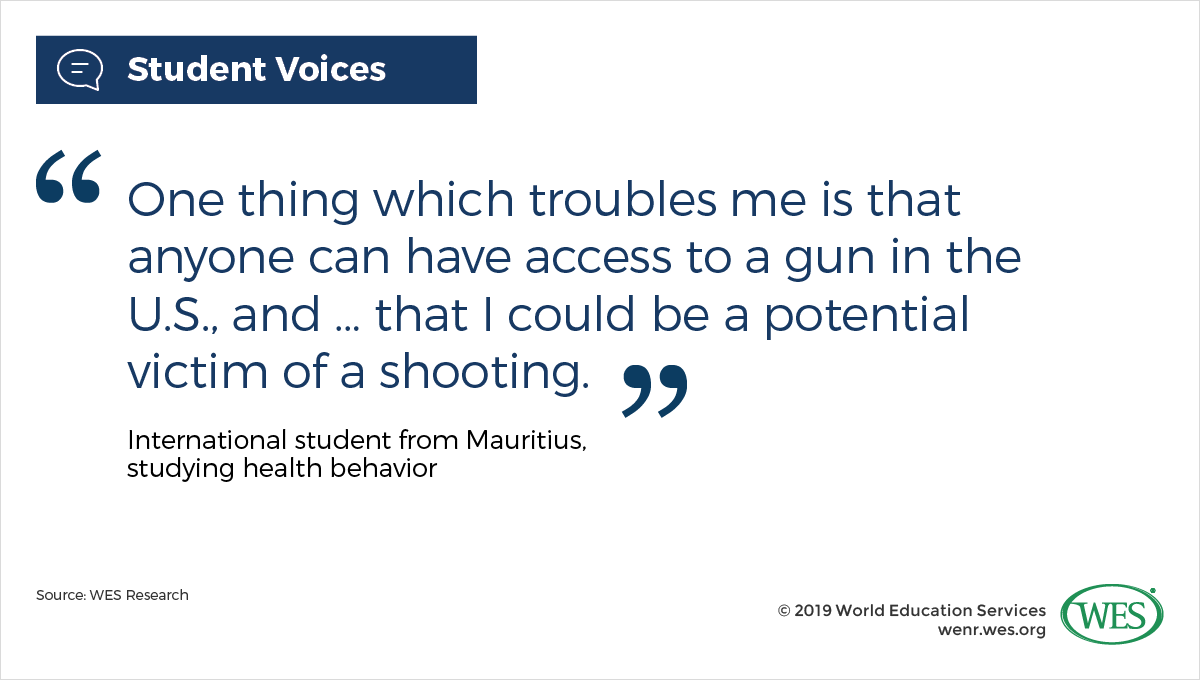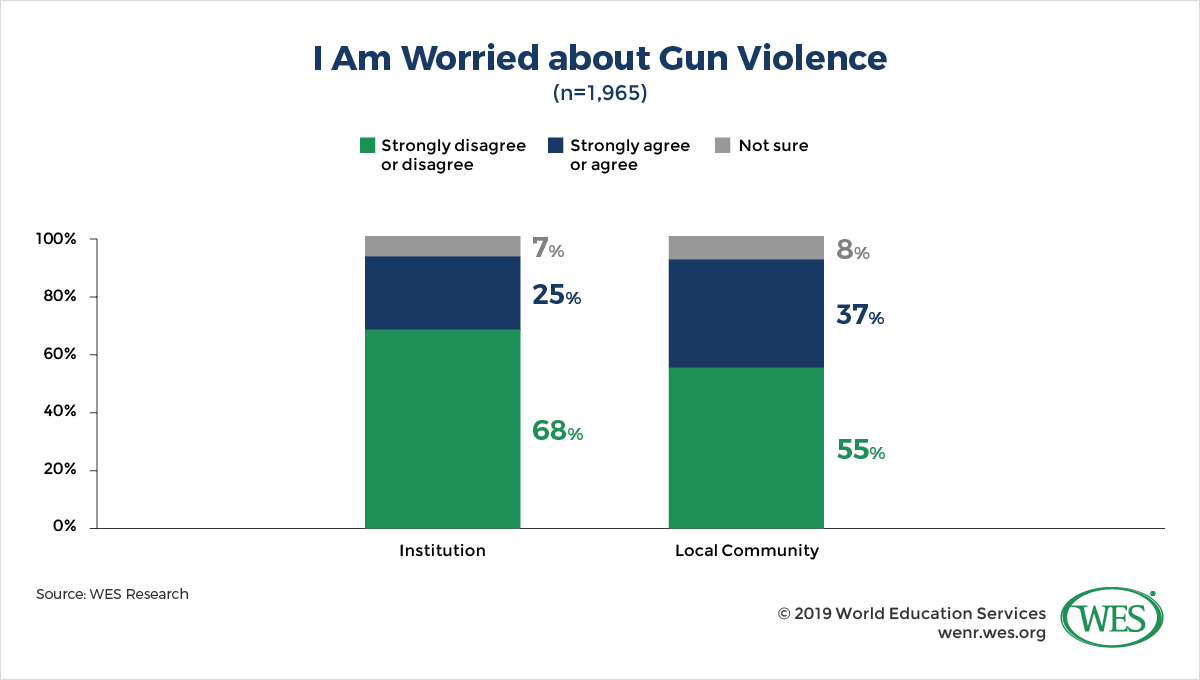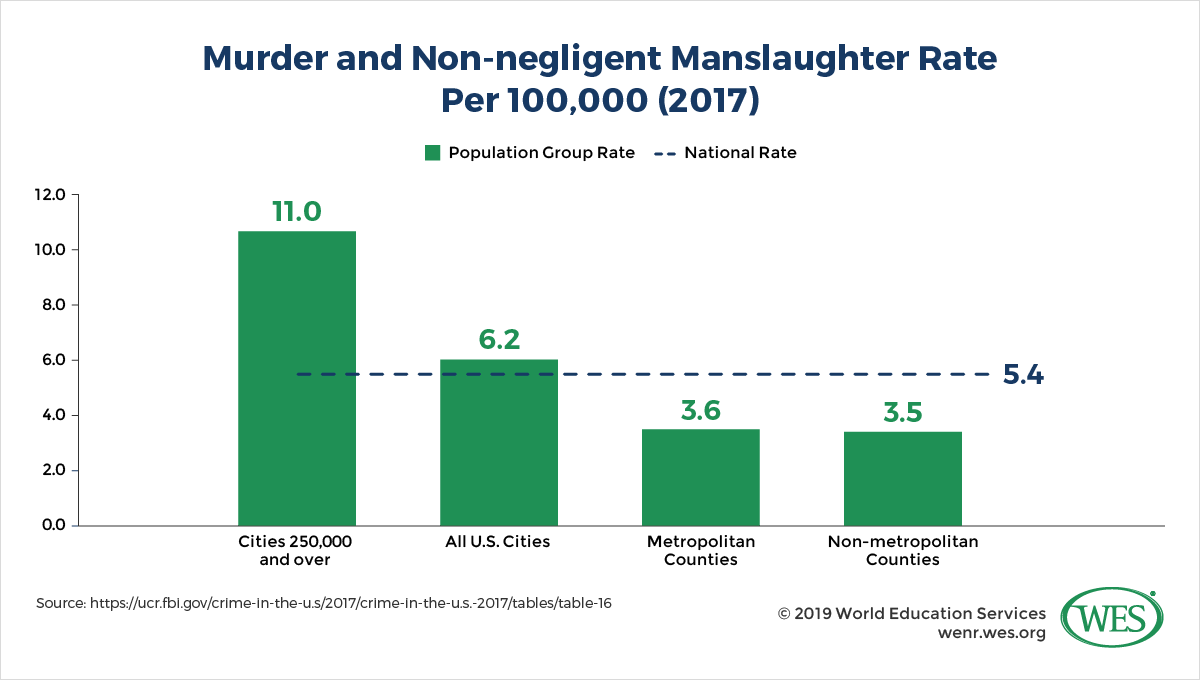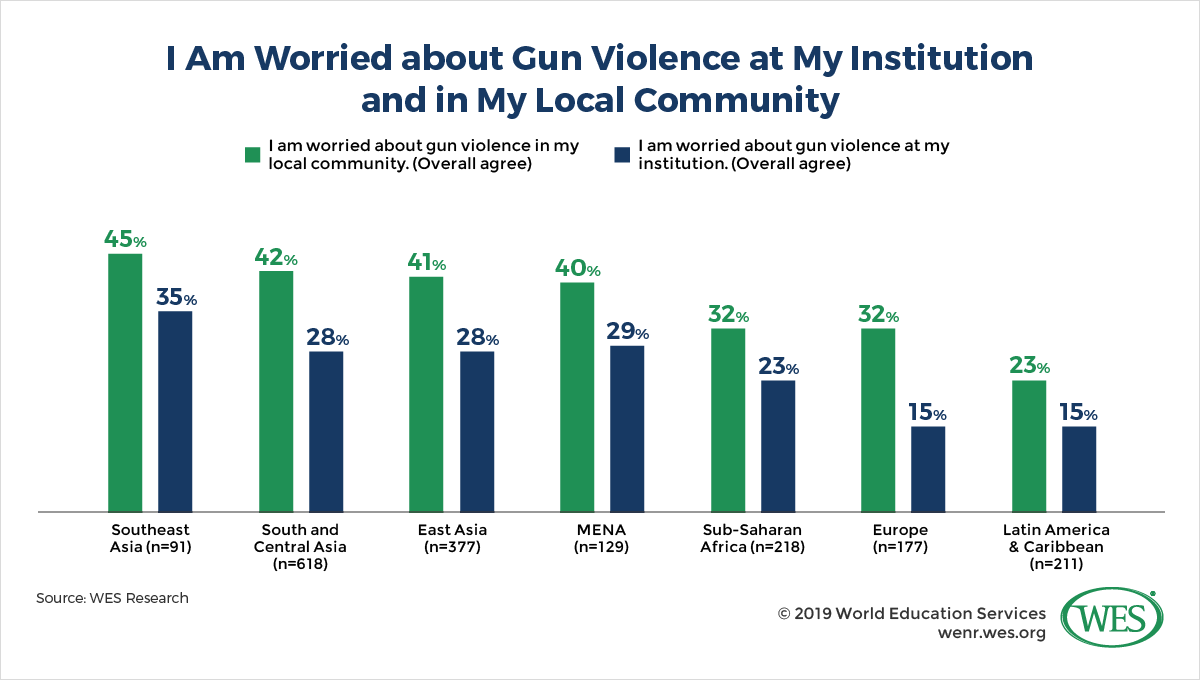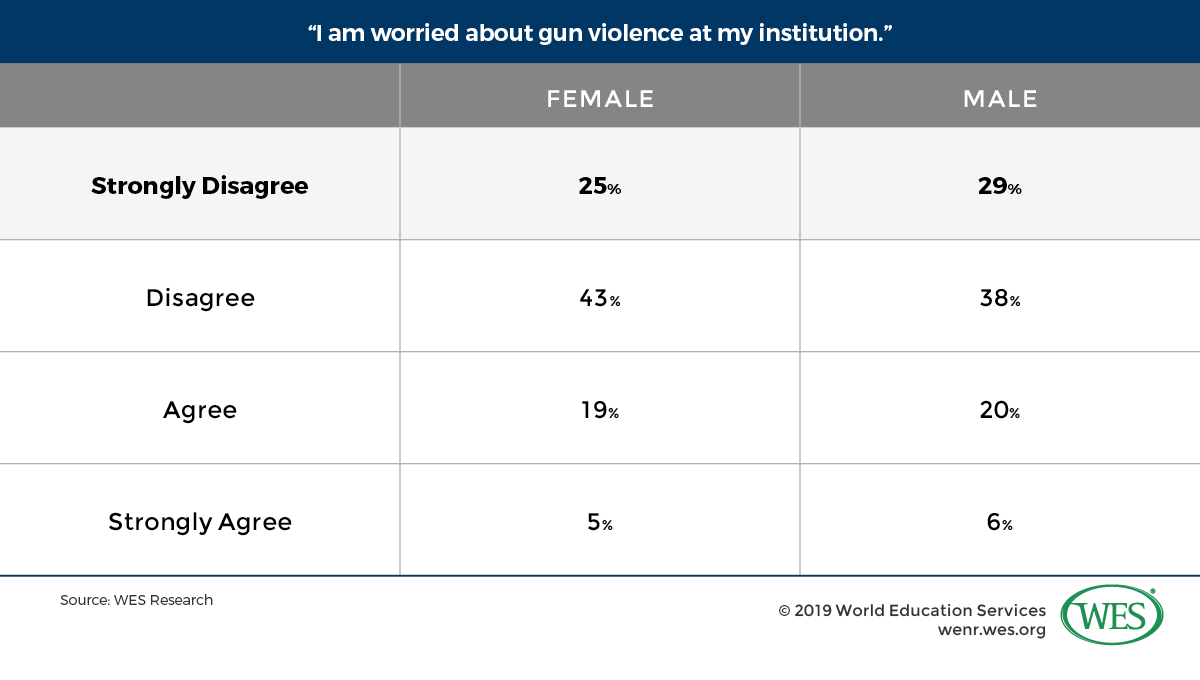Dismantling the Lethal Threat to International Enrollment: Student Views on Gun Violence and Safety
Chris Mackie, Research Associate, WES
Concerns about personal safety—particularly regarding the threat of gun violence—are growing among international students, according to a new survey of 1,921 respondents by WES. As institutions adapt their international enrollment management plans to cope with declining international enrollment, they must address this issue. Safety concerns threaten to not only slow future enrollment, but to diminish the experiences of current students.
While declining international student enrollment at U.S. higher education institutions (HEIs) is attributable to myriad factors, the prevalence of gun violence in the U.S. and the resulting perception that its colleges and universities are unsafe are real and growing concerns. Though the Institute of International Education’s (IIE) Fall 2018 survey confirmed that there are multiple causes for the softer numbers, it also revealed that between 2017 and 2018, no single concern grew faster than “physical safety in the United States (e.g., gun violence, civil unrest).” By the fall of 2018, 44 percent of institutions surveyed listed concerns about physical safety as a factor contributing to the declines in international enrollment, up from 33 percent in 2017, and just 12 percent in 2016.
A 2018 IDP survey of international students lends support to IIE’s findings. In a survey of just under 3,000 prospective and current international students, the U.S. placed well behind its four largest English-speaking competitors1 in terms of student perceptions of safety. The U.S. also placed last in IDP’s 2016 and 2017 surveys.
A 2019 WES survey of 1,921 international students, which will culminate in a research report this fall, examined several dimensions of international student experiences, including safety and security. This article examines those results through a variety of lenses, and suggests specific responses for HEIs.
WES Survey Results
Many of the results are encouraging. Nearly nine in ten respondents (88 percent) report feeling safe from physical harm or acts of violence at their institution. Fewer, although still the vast majority (79 percent), feel safe in their local community. A similar distribution holds for perceptions of verbal harm or harassment (see Figure 1).
Although students report a general sense of security from physical and verbal harm, responses to specific safety risks elicit concern. A quarter of respondents say they are worried about gun violence at their institution. Concerns are even higher in the local community, where nearly two in five respondents (37 percent) express anxieties about gun violence (see Figure 2).
Differences by Setting
Perceptions of gun violence in the local community vary across institutional settings. Respondents at suburban institutions are the least likely (31 percent) to report concerns about gun violence in their local community. At rural institutions, respondents report higher levels of concern (35 percent), possibly because of the higher rates of gun ownership in rural communities. According to a 2017 Pew Research Center survey, adults living in rural communities were most likely to own a firearm, with nearly six in ten (58 percent) reporting that at least one person in their household owned a gun.
International students attending institutions in cities report the highest levels of concern (39 percent). The concentration of crime in the largest cities of the U.S. likely contributes to this unease. According to data from the Federal Bureau of Investigation’s (FBI) Uniform Crime Reporting Program, crime of all kinds is more prevalent in urban areas than in suburban or rural areas. Homicide in particular—73 percent of homicides in 2017 were committed using a firearm—is concentrated in the country’s most densely populated areas, despite overall lower rates of gun ownership. While the aggregate national homicide rate was 5.4 per 100,000 in 2017, cities with a population above 250,000 had a rate more than twice as high, at 11.0 per 100,000 (see Figure 3).
Differences by Region of Origin
Perceptions of gun violence also vary across the student’s region of origin. Students from Southeast Asia are the most worried both at their institution (35 percent) and in their local community (45 percent). Students from South and Central Asia, East Asia, and the Middle East/North Africa (MENA) also express high levels of concern (see Figure 4). The high rates of homicide and civilian gun ownership in the U.S. could very well cause concern, especially for students from Asia, which has some of the lowest rates of homicide and civilian gun ownership in the world. For students from the MENA region, which is majority Muslim, the current political and social environment in the U.S. may understandably make them feel less safe. FBI hate crime statistics reveal the extent of the danger posed to Muslims. Despite making up only around 1 percent of the U.S. population, Muslims were the target of nearly 25 percent of all hate crimes motivated by religious bias in 2016, the highest level since 2001.
Differences by Gender
Subtle differences in perceptions of gun violence exist between male and female international students. To the statement “I am worried about gun violence at my institution,” female respondents are less likely to indicate Strong Disagreement (25 percent) than male respondents (29 percent) (see Figure 5). The unique vulnerability of women to violence is a worldwide problem. Women are not only at risk of violence perpetrated by strangers but are also uniquely vulnerable to violence committed by familiar acquaintances in private spaces.
Recommendations for HEIs
This survey examined international student perceptions of safety in three key experience areas: safety from physical violence, safety from emotional harm, and safety from gun violence. Perceptions of safety are important both for the retention of current students and for the recruitment of future students. Studies have shown the importance of word of mouth and peer recommendations in influencing student decisions on where to study. They also repeatedly emphasize the importance of safety in determining a prospective international student’s study destination.
Many of the measures long in place to protect domestic students will be effective in increasing the safety of international students. However, international students often possess a number of intersecting characteristics, such as gender and nationality, that make them more vulnerable than domestic students to acts of physical and emotional harm. This heightened vulnerability justifies support measures specifically targeted at the international student population. Some important measures to both protect and empower international students are outlined below.
Student Voices
A graduate student from Saudi Arabia recommended that institutions provide a list of nearby neighborhoods and their resources, such as restaurants, pharmacies, libraries, grocery stores, and houses of worship; as well as their downsides, such as how dangerous or expensive they are, or if they lack amenities. The student also suggested providing a brief orientation about rights and safety, how to deal with the police, and what to do when confronted by a dangerous person.
1. Expand access to safe and affordable housing.
Studies of domestic student populations suggest that financial insecurity compels students to seek low-cost housing, often in areas that are poor, underresourced, and possibly unsafe. High, unsubsidized tuition fees, limited access to financial aid, and work visa restrictions make safely managing financial vulnerability even more difficult for international students. Other studies have emphasized “the relationship between students’ need for housing that is priced at the lower end of the market and increased risk of victimization” (Helen Forbes-Mewett et al., 2015, pp. 68–69). Increasing the availability of safe and affordable accommodations for international students is highly recommended. Other measures institutions should consider include:
- Communicating to international students (preferably pre-arrival) the rates of crime both on campus and in nearby neighborhoods. Our survey reveals room for improvement in this area, with more than a quarter of international students (26 percent) reporting that their institution did not provide adequate information about their local community.
- Maintaining and distributing registers of recommended local housing which meet safety and other quality standards.
2. Expand access to safe transportation services and practices.
Our survey reveals that just over half (51 percent) of all international students find transportation challenging. Like housing, safe transportation is of critical importance to physical and emotional security and well-being. Consider:
- Developing and advertising new, or expanding older, all-night intra-campus and campus-to-community bus or shuttle services.
- Implementing a buddy system in which students can request on-demand accompaniment to an on- or off-campus location from fellow students, administrative staff, or campus security or law enforcement officers.
- Publicizing the geographic range and routes of on- and off-campus security or police patrols.
3. Provide students with accurate information on local laws and customs, as well as their rights and responsibilities.
Studies suggest that new immigrants are likely to underreport crime. Campus security officers suggest that international students are no different. Underreporting may be driven by, among other reasons, fears over visa status, social stigma (especially in the case of gender violence), and unfamiliarity with the legal code. International students may also believe they have fewer rights than U.S. citizens. Knowledge of local laws and legal rights is likely to increase the propensity of international students to report issues, seek help, and take proactive steps to protect themselves. Consider:
- Informing international students of their rights and legal options in the event of victimization or perceived risk. Focus on areas of especial relevance to international students and areas where confusion may arise as a result of differing conditions in home countries, such as immigration law, criminal law (gender violence and harassment in particular), tenancy laws, employment rights, and Health Insurance Portability and Accountability Act (HIPAA) and privacy rights. Provide references to local legal professionals, law enforcement officials, and support and advocacy groups.
- Reassuring international students that interactions with the police and the reporting of incidents to university staff will be subject to the relevant privacy laws and will not be reflected on their transcripts or affect their visa status.
4. Collaborate with key campus and local community stakeholders.
The international student experience is not confined to the classroom. International students engage with colleagues, faculty, and administrators from across the campus. They also interact with residents, professionals, and government officials throughout the larger community. Collaborating with community stakeholders can overcome many of the challenges to crafting and implementing effective harm-prevention strategies. Consider:
- Building formal working relationships and leveraging partnerships to develop harm-prevention strategies and trainings for international students. Workshops, pamphlets, and other educational initiatives are enhanced by the specific expertise and knowledge of various campus and community professionals, such as campus security officers, local law enforcement, legal and health professionals, and advocacy groups.
- Establishing standardized communication protocols between key stakeholders both on and off campus to facilitate the sharing of vital information on current issues affecting the international student body. Standardized information-sharing protocols allow incident reports to be directed to the relevant offices and professionals, and also allow students to be referred to appropriate support services.
- Prioritizing initiatives which seek to build ties between stakeholders and international students, through targeted social media campaigns, meet-and-greet events, and outreach to international student organizations. These partnerships can build trust, facilitate the two-way flow of critical information, and increase rates of incident reporting.
5. Develop interventions targeted at high risk international student populations.
International students are not a homogeneous body. Institutions should craft strategies which target international student groups that are particularly vulnerable.
Fifty-five percent of the respondents in our survey were women. Nationwide, women made up nearly 43 percent of the total international student population in 2016. Their high numbers on campus and unique vulnerability suggest that institutions should prioritize finding ways of supporting them. It is highly recommended that institutions develop, deliver, and publicize resources and community-wide support services that are available to female international students. Holding workshops that address their specific vulnerabilities may also be of use. Laws and cultural norms relating to crimes and sexual violence should also be clarified, since in their home countries the situation may differ dramatically.
In the 2017/18 academic year, international students came to the U.S. from well over 200 countries. Their sense of vulnerability differs by home country and by the way U.S. citizens interact with them. Providing targeted resources and trainings to students from certain at-risk nationalities or ethnicities is recommended.
Gun Ownership and Violence: Unique to the U.S.
Despite the reputation of the U.S. as the least safe of the major international study destinations, the vast majority of its international students will not become victims of crime. Those who do are overwhelmingly likely to experience non-violent property crimes, such as theft and burglary—a category of crime with rates in the U.S. that are comparable to those of other OECD countries. But it is violent crime, lethal violence in particular, that differentiates the U.S. from other developed nations and gives the country its reputation for danger. In 2016, of 29 OECD countries included in UN intentional homicide statistics,2 the U.S. homicide rate was the second highest at 5.4 per 100,000, trailing only Mexico (at 19.3 per 100,000), and well above the OECD country average (1.9 per 100,000). The U.S. also leads not just developed countries but the world in rates of gun ownership. At the end of 2017, despite making up just over 4 percent of the world’s total population, its citizens owned over 45 percent of the world’s 857 million civilian-held firearms. With nearly three-quarters of all homicides committed using a firearm that same year, the reason for the high homicide rate in the U.S. is evident.
For many years, international students have been willing to risk the dangers of the U.S. in return for the high-quality education it provides, and its enduring reputation as a country that offers newcomers good opportunities for advancement. While institutions can do little to affect the seemingly intractable issue of gun violence in the U.S., they must take steps to reduce the risk of criminal victimization that can raise a red flag for prospective international students. To be fully effective, these steps must be designed with the unique challenges and vulnerabilities of international students in mind.
1. Australia, Canada, New Zealand, and the United Kingdom
2. Homicide rates from only 29 OECD countries were included in the UN statistics for 2016. Data from Belgium, Estonia, Israel, Latvia, Luxembourg, New Zealand, and Turkey were not reported.

